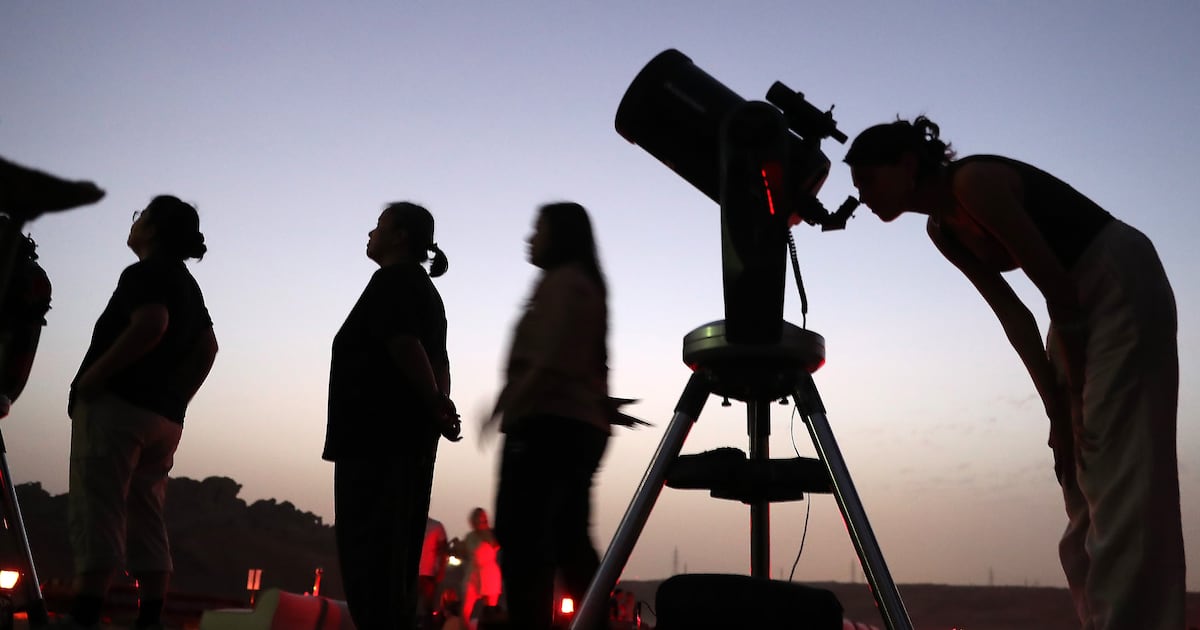Stargazers in the UAE may catch an early glimpse of the Perseids meteor shower on July 24, when moonless, darker skies offer a better chance of spotting shooting stars.
While the annual showers typically dazzle in mid-August with up to 100 meteors an hour, this year’s peak will coincide with a full moon. On Thursday, however, the Moon will be not be visible, creating ideal conditions for observing celestial events such as the Perseids, active from mid-July until late August.
Khadijah Ahmed, operations manager at Dubai Astronomy Group, said the Perseids meteor shower takes place when Earth passes through the densest part of the debris trail left by Comet Swift-Tuttle.
“On July 24, the shower is still building up, so you might only see 10 to 20 meteors per hour at best, depending on your location, sky conditions and darkness,” she told The National.
“Unfortunately, there is a full moon just before the Perseid peak in August, meaning bright moonlight will wash out many meteors during the peak nights, but that’s when you typically get 60 to 100 meteors per hour under moonless conditions.”
The Perseids are one of the most anticipated meteor showers of the year, which produces bright streaks of light as the particles burn up in the atmosphere, with the most intense activity typically on August 12 and 13.
This year, however, conditions are not looking ideal because moonlight is likely to interfere with the shower’s visibility. The Dubai Astronomy Group will host a stargazing event on August 12 in Jebel Jais in Ras Al Khaimah for the public, with tickets priced at Dh200 ($54) per adult.
“We’ll focus more on stargazing, observing all the visible objects in the sky with a sideshow of the meteor,” said Ms Ahmed. “As the meteor shower will continue till late August, we might host another event depending on the weather to observe the meteors on moonless nights.”
Mohamed Usama Ismail, lead of optical astronomy and tours at Al Sadeem Astronomy in Abu Dhabi, said viewing the Perseids, whether on July 24 or during the August peak, comes down to “timing and luck”. He said visibility can vary from year to year.
“Last year, it was a bit strange,” he said. “People came to observe the Perseids on August 12 and 13 but didn’t see much. I wasn’t sure why. Then, on August 14, a group visited and saw no fewer than 50 meteors, so it’s all about luck.”
There have been reports in recent years that the Perseids’ intensity is declining and that the shower may not produce as many meteors as it once did.
Astronomers believe the showers are weaker now because thicker parts of the comet’s debris, which caused intense displays of meteors in the 1990s, have slowly spread out over time, causing fewer visible meteors today.
Al Sadeem Astronomy is not hosting a specific event for public viewing of the meteor shower, but tours of its observatory are available regularly. After the showers, the next celestial event set to take place in the UAE will be a total lunar eclipse, appearing in the skies on September 7. The Moon will pass through Earth’s shadow, turning a deep reddish colour.
“This is one of the rare astronomical events happening in the UAE in 2025,” said Ms Ahmed. “We will host an event for the eclipse and encourage everyone to witness it. You don’t need any special equipment – just go outside and look up.”
The first supermoon of the year, the Hunter’s Supermoon, will appear on October 7, followed by the Beaver on November 5 and the Cold Supermoon on December 4.
There are more meteor showers after the Perseids, including the Orionids’ peak on October 21 and 22, followed by the Leonids, peaking on November 17 and 18. The best meteor shower and often the most visible, the Geminids, will peak on December 13 and 14.
